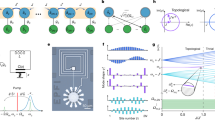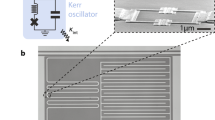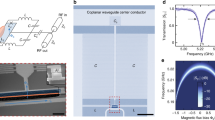Abstract
The combination of low mass density, high frequency and high quality factor, Q, of mechanical resonators made of two-dimensional crystals such as graphene1,2,3,4,5,6,7,8 make them attractive for applications in force/mass sensing and exploring the quantum regime of mechanical motion. Microwave optomechanics with superconducting cavities9,10,11,12,13,14 offers exquisite position sensitivity10 and enables the preparation and detection of mechanical systems in the quantum ground state15,16. Here, we demonstrate coupling between a multilayer graphene resonator with quality factors up to 220,000 and a high-Q superconducting cavity. Using thermomechanical noise as calibration, we achieve a displacement sensitivity of 17 fm Hz−1/2. Optomechanical coupling is demonstrated by optomechanically induced reflection and absorption of microwave photons17,18,19. We observe 17 dB of mechanical microwave amplification13 and signatures of strong optomechanical backaction. We quantitatively extract the cooperativity C, a characterization of coupling strength, from the measurement with no free parameters and find C = 8, which is promising for the quantum regime of graphene motion.
This is a preview of subscription content, access via your institution
Access options
Subscribe to this journal
Receive 12 print issues and online access
$259.00 per year
only $21.58 per issue
Buy this article
- Purchase on Springer Link
- Instant access to full article PDF
Prices may be subject to local taxes which are calculated during checkout




Similar content being viewed by others
References
Bunch, J. S. et al. Electromechanical resonators from graphene sheets. Science 315, 490–493 (2007).
Chen, C. et al. Performance of monolayer graphene nanomechanical resonators with electrical readout. Nature Nanotech. 4, 861–867 (2009).
Singh, V. et al. Probing thermal expansion of graphene and modal dispersion at low-temperature using graphene nanoelectromechanical systems resonators. Nanotechnology 21, 165204 (2010).
Barton, R. A. et al. High, size-dependent quality factor in an array of graphene mechanical resonators. Nano Lett. 11, 1232–1236 (2011).
Eichler, A. et al. Nonlinear damping in mechanical resonators made from carbon nanotubes and graphene. Nature Nanotech. 6, 339–342 (2011).
Song, X. et al. Stamp transferred suspended graphene mechanical resonators for radio frequency electrical readout. Nano Lett. 12, 198–202 (2012).
Barton, R. A. et al. Photothermal self-oscillation and laser cooling of graphene optomechanical systems. Nano Lett. 12, 4681–4686 (2012).
Chen, C. et al. Graphene mechanical oscillators with tunable frequency. Nature Nanotech. 8, 923–927 (2013).
Regal, C. A., Teufel, J. D. & Lehnert, K. W. Measuring nanomechanical motion with a microwave cavity interferometer. Nature Phys. 4, 555–560 (2008).
Teufel, J. D., Donner, T., Castellanos-Beltran, M. A., Harlow, J. W. & Lehnert, K. W. Nanomechanical motion measured with an imprecision below that at the standard quantum limit. Nature Nanotech. 4, 820–823 (2009).
Rocheleau, T. et al. Preparation and detection of a mechanical resonator near the ground state of motion. Nature 463, 72–75 (2010).
Teufel, J. D. et al. Circuit cavity electromechanics in the strong-coupling regime. Nature 471, 204–208 (2011).
Massel, F. et al. Microwave amplification with nanomechanical resonators. Nature 480, 351–354 (2011).
Hocke, F. et al. Electromechanically induced absorption in a circuit nano-electromechanical system. New J. Phys. 14, 123037 (2012).
Teufel, J. D. et al. Sideband cooling of micromechanical motion to the quantum ground state. Nature 475, 359–363 (2011).
Palomaki, T. A., Teufel, J. D., Simmonds, R. W. & Lehnert, K. W. Entangling mechanical motion with microwave fields. Science 342, 710–713 (2013).
Agarwal, G. S. & Huang, S. Electromagnetically induced transparency in mechanical effects of light. Phys. Rev. A 81, 041803 (2010).
Weis, S. et al. Optomechanically induced transparency. Science 330, 1520–1523 (2010).
Safavi-Naeini, A. H. et al. Electromagnetically induced transparency and slow light with optomechanics. Nature 472, 69–73 (2011).
Aspelmeyer, M., Kippenberg, T. J. & Marquardt, F. Cavity optomechanics. Preprint at http://arXiv.org/abs/1303.0733. Accepted in Rev. Mod. Phys. (2014).
Chan, J. et al. Laser cooling of a nanomechanical oscillator into its quantum ground state. Nature 478, 89–92 (2011).
Castellanos-Gomez, A. et al. Deterministic transfer of two-dimensional materials by all-dry viscoelastic stamping. 2D Materials 1, 011002 (2014).
Zhou, X. et al. Slowing, advancing and switching of microwave signals using circuit nanoelectromechanics. Nature Phys. 9, 179–184 (2013).
Gorodetsky, M. L., Schliesser, A., Anetsberger, G., Deleglise, S. & Kippenberg, T. J. Determination of the vacuum optomechanical coupling rate using frequency noise calibration. Opt. Express 18, 23236–23246 (2010).
Weiss, T., Bruder, C. & Nunnenkamp, A. Strong-coupling effects in dissipatively coupled optomechanical systems. New J. Phys. 15, 045017 (2013).
Elste, F., Girvin, S. M. & Clerk, A. A. Quantum noise interference and backaction cooling in cavity nanomechanics. Phys. Rev. Lett. 102, 207209 (2009).
Acknowledgements
The authors thank A. Clerk for providing initial theoretical input. This work was supported by the Dutch Organization for Fundamental Research on Matter (FOM) and the Netherlands Organization for Scientific Research (NWO). A.C.G. acknowledges financial support through the FP7-Marie Curie project PIEF-GA-2011-300802 (‘STRENGTHNANO’).
Author information
Authors and Affiliations
Contributions
V.S., S.B. and B.S. optimized and fabricated the quarter-wavelength superconducting cavity samples. A.C.G. developed the deterministic transfer method. V.S. and A.C.G. transferred graphene onto the superconducting cavity samples. V.S. and S.B. set up the low-temperature microwave measurement set-up. V.S. performed the measurement. Y.B. provided theoretical support. G.A.S. conceived the experiment and supervised the work. All authors contributed to writing the manuscript and provided critical comments.
Corresponding authors
Ethics declarations
Competing interests
The authors declare no competing financial interests.
Supplementary information
Supplementary information
Supplementary Information (PDF 3422 kb)
Rights and permissions
About this article
Cite this article
Singh, V., Bosman, S., Schneider, B. et al. Optomechanical coupling between a multilayer graphene mechanical resonator and a superconducting microwave cavity. Nature Nanotech 9, 820–824 (2014). https://doi.org/10.1038/nnano.2014.168
Received:
Accepted:
Published:
Issue Date:
DOI: https://doi.org/10.1038/nnano.2014.168
This article is cited by
-
Graphene nanomechanical vibrations measured with a phase-coherent software-defined radio
Communications Engineering (2024)
-
Extreme mechanical tunability in suspended MoS2 resonator controlled by Joule heating
npj 2D Materials and Applications (2023)
-
Tunable optical response properties in a Laguerre-Gaussian rovibrational cavity system with a mechanical pump
Quantum Information Processing (2023)
-
Probe response of photonic cavity with graphene sheet: slow light and fast light
Journal of Optics (2023)
-
Signatures and detection prospects for sub-GeV dark matter with superfluid helium
Journal of High Energy Physics (2023)



